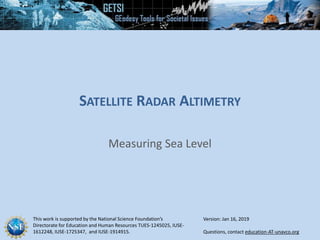
Overview of Satellite Radar Altimetry
- 1. This work is supported by the National Science Foundation’s Directorate for Education and Human Resources TUES-1245025, IUSE- 1612248, IUSE-1725347, and IUSE-1914915. Questions, contact education-AT-unavco.org SATELLITE RADAR ALTIMETRY Measuring Sea Level Version: Jan 16, 2019
- 2. OCEAN SURFACE TOPOGRAPHY • Topography is the shape of a surface, including its relief • Sea surface topography is influenced by both gravity and ocean circulation • The shape of the Earth is not a perfect sphere nor a perfect ellipsoid (an effect of its rotation), but it is close to an ellipsoid • Irregularities in the crust produce an irregular surface, referred to as the geoid (the actual shape of the Earth at sea level)
- 3. THE BASIC PRINCIPLE OF SATELLITE RADAR ALTIMETRY • Altimetry is a technique for measuring height. • Satellite radar altimetry measures the time taken by a radar pulse to travel from the satellite antenna to the surface and back to the the satellite receiver.
- 4. THE BASIC PRINCIPLE OF SATELLITE RADAR ALTIMETRY • Altimetry is a technique for measuring height. • Satellite radar altimetry measures the time taken by a radar pulse to travel from the satellite antenna to the surface and back to the the satellite receiver.
- 5. Basic Principles • The altimeter is a radar at vertical incidence • The signal returning to the satellite is from quasi- specular reflection • Measure distance between satellite and sea (range) • Determine position of satellite (precise orbit) • Hence determine height of sea surface • Oceanographers require height relative to geoid Sea SurfaceGeoid Reference ellipsoid Satellite orbit Geoid undulation Ocean dynamic surface topography (DT) DT= Orbit - Range - Geoid Altimeter measurement (range) Orbit height
- 6. MEASURING SEA LEVEL USING SATELLITE RADAR ALTIMETRY • Satellite altimeter radar measurements can be combined with precisely known spacecraft orbits to measures sea level globally with high accuracy (3-4 mm). • A series of satellite missions have estimated global mean sea level every 10 days since 1992.
- 7. ANIMATION OF TOPEX/POSEIDON GROUND TRACKS
- 9. meters
- 10. GLOBAL MEAN SEA LEVEL FROM SATELLITE MISSIONS TOPEX/POSEIDON, AND JASON-1, JASON-2 AND JASON-3
- 11. TOTAL SEA LEVEL CHANGE SINCE 1993
Editor's Notes
- Reference ellipsoid is our best approximation of the squished not-quite-a-sphere shape of the Earth. The geoid is the bumpy ocean surface that is free of time-varying effects like tides and currents. In continental areas, the undulatory surface of the reference geoid can be estimated as the level that would be taken by the surface of the sea in a set of criss-crossing canals stretching across the land from coast to coast. Just like the ocean floor, land surfaces have mountains, valleys, and other topographic features that affect the local gravity field and thus, the reference geoid. The complicated nature of the reference geoid explains why a simplified smooth reference ellipsoid is instead used in GPS receivers! To find the surface caused by ocean circulation, scientists mathematically remove the sea height caused by gravity (the geoid) and create maps of ocean topography. They then calculate the speed and direction of ocean currents similar to how meteorologists use atmospheric pressure maps to calculate winds. https://sealevel.jpl.nasa.gov/overview/oceansurfacetopo/
- To measure sea surface height scientists must know the satellite’s position in its orbit and the height between the satellite and the ocean’s surface. Other factors that may need to be corrected for include variable amounts of water vapor in the lower atmosphere, and free electrons in the upper atmosphere, both of which can delay microwave pulses. Text from: https://sealevel.jpl.nasa.gov/overview/oceansurfacetopo/ Image: http://www.altimetry.info/radar-altimetry-tutorial/how-altimetry-works/basic-principle/ --this is an ESA (European Space Agency) website and materials are available for educational use
- To measure sea surface height scientists must know the satellite’s position in its orbit and the height between the satellite and the ocean’s surface. Other factors that may need to be corrected for include variable amounts of water vapor in the lower atmosphere, and free electrons in the upper atmosphere, both of which can delay microwave pulses. Text from: https://sealevel.jpl.nasa.gov/overview/oceansurfacetopo/ Image: https://www.star.nesdis.noaa.gov/sod/lsa/SeaLevelRise/LSA_SLR_background.php
- Reference ellipsoid is our best approximation of the squished not-quite-a-sphere shape of the Earth. The geoid is the bumpy ocean surface that is free of time-varying effects like tides and currents. This is slides from an European Space Agency tutorial presentation that covers many of the technical details of how satellite altimetry is measured. The conference where this was presented is noted on the bottom of the slide. This is one of the introductory slides from that presentation. The full presentation can be found at: https://earth.esa.int/documents/10174/950521/01_Tuesday_OCT2013_Cipollini_Altimetry_1.pdf - Paolo Cipollini, Helen Snaith ESA images are allowed to be used for educational purposes. https://www.noc.ac.uk/disclaimer
- https://www.star.nesdis.noaa.gov/sod/lsa/SeaLevelRise/
- This animation shows the tracks of the TOPEX/Poseidon satellite, which measured sea level height from 1992-2005. If you mouse over the middle of the image you should activate a play bar below the image. Every 10 days the Jason series of satellites (2002-present) measure the sea level height of more than 90% of the world’s ice free oceans with radar altimetry. https://sealevel.jpl.nasa.gov/overview/oceansurfacetopo/ (public domain)
- Example of a portion of a single track from the TOPEX/Poseidon satellite altimeter showing the sea surface height anomaly in meters. https://earth.esa.int/documents/10174/950521/01_Tuesday_OCT2013_Cipollini_Altimetry_1.pdf - Paolo Cipollini, Helen Snaith ESA images are allowed to be used for educational purposes. https://www.noc.ac.uk/disclaimer
- Scale bar given in meters https://earth.esa.int/documents/10174/950521/01_Tuesday_OCT2013_Cipollini_Altimetry_1.pdf - Paolo Cipollini, Helen Snaith ESA images are allowed to be used for educational purposes. https://www.noc.ac.uk/disclaimer
- Global mean sea level with seasonal signals removed. The colors show data collected during the different satellite missions. A image capture of the site where this image can be found is in the resources section at end of this PowerPoint. http://sealevel.colorado.edu/
- Sea level rise is spatially heterogeneous. Note- this data set doesn’t indicate which year this graph was made. https://www.star.nesdis.noaa.gov/sod/lsa/SeaLevelRise/
- https://sealevel.jpl.nasa.gov/
- https://www.star.nesdis.noaa.gov/sod/lsa/
- http://sealevel.colorado.edu/